

Disaster Resilience. Natural hazards such as hurricanes, tsunamis and earthquakes can lead to disasters when they strike vulnerable communities.
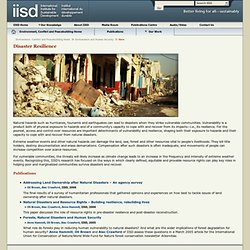
Vulnerability is a product both of physical exposure to hazards and of a community's capacity to cope with and recover from its impacts—i.e., its resilience. For the poorest, access and control over resources are important determinants of vulnerability and resilience, shaping both their exposure to hazards and their capacity to cope with and recover from natural disasters. Extreme weather events and other natural hazards can damage the land, sea, forest and other resources vital to people's livelihoods. They kill title holders, destroy documentation and erase demarcations.
Compensation after such disasters is often inadequate, and movements of people can increase competition over scarce resources. For vulnerable communities, the threats will likely increase as climate change leads to an increase in the frequency and intensity of extreme weather events. Hyogo Framework for Action (HFA) World Conference for Disaster Reduction The 10-year Hyogo Framework for Action came out of the World Conference held in Kobe, Hyogo, Japan, from 18 to 22 January 2005.
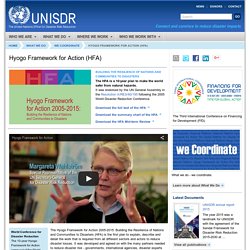
Crisis Mapping for Disaster Preparedness, Mitigation and Resilience. Crisis mapping for disaster preparedness is nothing new.
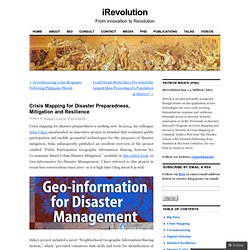
In 2004, my colleague Suha Ulgen spearheaded an innovative project in Istanbul that combined public participation and mobile geospatial technologies for the purposes of disaster mitigation. Suha subsequently published an excellent overview of the project entitled “Public Participation Geographic Information Sharing Systems for Co-mmunity Based Urban Disaster Mitigation,” available in this edited book on Geo-Information for Disaster Management. I have referred to this project in count-less conversations since 2007 so it is high time I blog about it as well. Suha’s project included a novel “Neighborhood Geographic Information Sharing System,” which “provided volunteers with skills and tools for identification of seismic risks and response assets in their neighborhoods.
Field data collection volunteers used low-cost hand-held computers and data compiled was fed into a geospatial database accessible over the Internet. Like this: Re-Thinking Resilience: What Disasters Teach us About Community Capacity. A double rainbow shines over Lower Manhattan on the day after Hurricane Sandy / Photo: Kurt Deitrich via Instagram PPS has been working extensively over the last year with Peter Smith, the Chief Executive Officer of the Adelaide City Council in Australia to create new models of governance and organizational culture that are more supportive of Placemaking, and institutionalize Placemaking principles, tools and process.
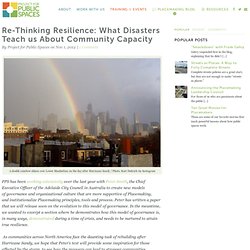
Peter has written a paper that we will release soon on the evolution to this model of governance. In the meantime, we wanted to excerpt a section where he demonstrates how this model of governance is, in many ways, demonstrated during a time of crisis, and needs to be nurtured to attain true resilience. As communities across North America face the daunting task of rebuilding after Hurricane Sandy, we hope that Peter’s text will provide some inspiration for those affected by the storm, to see how the recovery can lead to stronger communities. Characteristics of Disaster-Resilient Communities. IFRC on bridging relief and development. Why animals matter in a disaster. WSPA protects the welfare of animals in disaster situations because we believe they can suffer and feel pain.
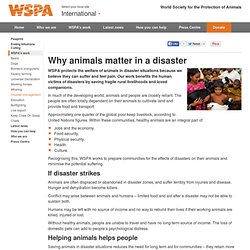
Our work benefits the human victims of disasters by saving fragile rural livelihoods and loved companions. In much of the developing world, animals and people are closely reliant. The people are often totally dependent on their animals to cultivate land and provide food and transport. Approximately one quarter of the global poor keep livestock, according to United Nations figures. Within these communities, healthy animals are an integral part of: Jobs and the economy.Food security.Physical security.Health.Culture. Building safer and resilient communities. Disaster risk reduction: Spending where it should count. What is Disaster Risk Reduction? Disaster risk reduction (DRR) There is no such thing as a 'natural' disaster, only natural hazards.
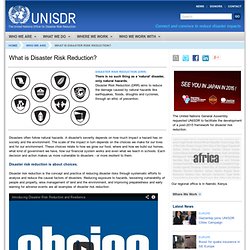
Disaster Risk Reduction (DRR) aims to reduce the damage caused by natural hazards like earthquakes, floods, droughts and cyclones, through an ethic of prevention. Disasters often follow natural hazards. A disaster's severity depends on how much impact a hazard has on society and the environment. The scale of the impact in turn depends on the choices we make for our lives and for our environment. Disasters & Sustainable Development. Disaster Risk Reduction. Disaster impacts have persistent, long-term negative effects on poverty and human development that undermine the achievement of the Millennium Development Goals (MDGs).
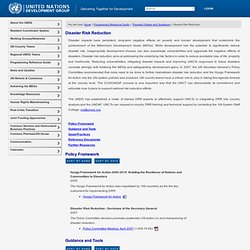
While development has the potential to significantly reduce disaster risk, inappropriate development choices can also exacerbate vulnerabilities and aggravate the negative effects of disasters. Disaster risk reduction aims at addressing the underlying risk factors in order to reduce avoidable loss of life, property and livelihoods. Reducing vulnerabilities, mitigating disaster impacts and improving UNCTs responses to future disasters correlate strongly with fostering the MDGs and safeguarding development gains.
In 2007, the UN Secretary-General’s Policy Committee recommended that more need to be done to further mainstream disaster risk reduction and the Hyogo Framework for Action into the UN system policies and practices. UN country teams have a critical role to play in taking this agenda forward at the country level. DRR and Building Resilience - Eldis Communities Group: DRR and Building Resilience. “Sharing experience and learning on Resilience from a range of organisations” The interagency group on Resilience brings together work from numerous organisations on DRR, CCA, conflict sensitivity and organisational change processes.
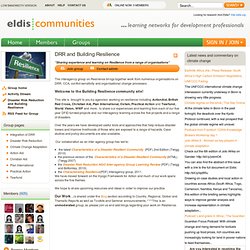
Welcome to the Building Resilience community site! This site is brought to you by agencies working on resilience including ActionAid, British Red Cross, Christian Aid, Plan International, Oxfam, Practical Action and Tearfund, World Vision, WWF and more.. to share our experiences and learning from each of our five year DFID funded projects and our interagency learning across the five projects and a range of disasters. Resilience: a risk management approach. Participatory Risk Analysis. Publication on Inclusive Disaster Risk Management. Disasters have a huge impact on human infrastructure, lives and livelihoods. They can result from natural causes (earthquakes, floods, cyclones, etc.) or from human-influenced factors (like climate change and conflicts), which can lead to food insecurity and displacement of large populations.
While it remains crucial to understand and reduce the human effect in creating disasters, natural causes will continue. The key in diminishing their impact is to reduce people’s vulnerability. Humanitarian Aid. UN urged to create global fund for disaster prevention. The NGO Islamic Relief has urged the UN to establish a global contingency fund for disaster prevention as it is cheaper to help prepare for floods and drought than spend billions on emergencies.
In a report on Monday, Feeling the Heat, the charity also called on governments and aid agencies to completely rethink their priorities and put disaster risk reduction at the heart of all aid programmes.